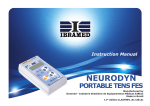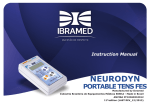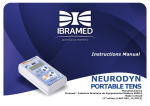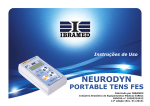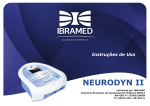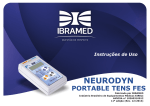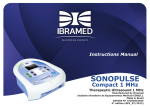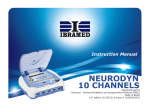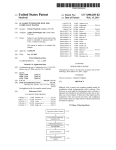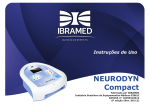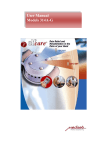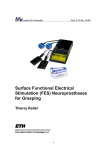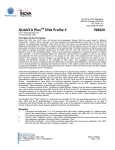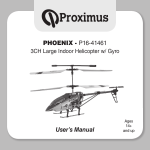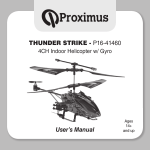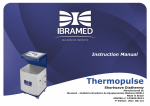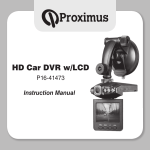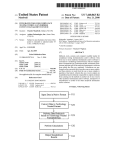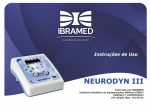Download Manual
Transcript
Instructions Manual NEURODYN II Manufactured by Ibramed - Indústria Brasileira de Equipamentos Médicos EIRELI Made in Brazil nd 2 edition (LASTREV_08/2014) TABLE OF CONTENTS Caution: Federal Law restricts this device to sale by or on the order of a practitioner licensed by the law of the State in which he/she practices to use or order the use of this device. OPERATING INSTRUCTIONS.....................................30 SYMBOL DEFINITIONS..................................................3 ELECTRODE GUIDELINE...........................................36 CARTON..............................................................4 USING THE MENU/PROG BUTTON..............................40 ABREVIATIONS GLOSSARY.............................................4 CLINICAL RESOURCES LIBRARY - CLINICAL PROTOCOLS..42 FOREWORD.................................................................6 REFERENCES..........................................................45 PRODUCT DESCRIPTION................................................6 ACCESSORIES ACCOMPANYING NEURODYN II............46 SAFETY PRECAUTIONS..................................................7 TROUBLESHOOTING................................................47 PRECAUTIONARY DEFINITIONS..............................7 ELECTROTHERAPY INDICATIONS....................................9 MAINTENANCE, WARRANTY AND TECHNICAL SUPPORT...48 CONTRAINDICATIONS, WARNINGS AND PRECAUTIONS....10 CEFAI – IBRAMED Center for Education and PREACAUTIONS AND ADVERSE REACTIONS....................11 Advanced Training.............................................50 GENERAL CARE WITH THE EQUIPMENT..........................12 INSTALLATION, CARE AND CLEANING....................12 ELETROMAGNECTIC COMPATIBILITY..............................14 NOMENCLATURE.........................................................20 CONTROLS, INDICATORS AND CONNECTIONS........20 SYMBOL DEFINITIONS........................................21 SPECIFICATIONS........................................................22 SYSTEM SPECIFICATIONS....................................22 WAVEFORM SPECIFICATIONS...............................23 REPLACEMENT ACCESSORIES..........................47 ACCESSORIES USED...................................................27 USING THE MENU/PROG BUTTON.................................29 2 SYMBOL DEFINITIONS BELOW ARE THE DEFINITIONS OF THE SYMBOLS USED ON THE EQUIPMENT AND THROUGHOUT THE INSTRUCTIONS FOUND IN THIS MANUAL. UNDERSTAND THESE SYMBOLS AND THEIR DEFINITIONS BEFORE OPERATING THIS EQUIPMENT. Start treatment. Stop treatment. Caution! Refer to user manual. Off switch. TYPE BF Electrical equipment. On switch. Dangerous voltage. Voltage in AC (Alternating Current). Electrical Network in AC (Alternating Current). CLASS II Electrical equipment. Not protected against the harmful effects of water penetration. Sensitivity against electrostatic discharge. 3 SYMBOL DEFINITIONS ABREVIATIONS GLOSSARY CARTON Fragile. This side up. Limits of temperature for storage and packaging in °C (Celsius Degrees). Keep away from the rain. Stacking up. Do not use damaged. if the packaging Hz Hertz (pulses per second) mA Milliampere VA Volt Ampere TENS Transcutaneous Electrical Nerve Stimulation FES Functional Electrical Stimulation Cont Continuous Sync Synchronous Rec Reciprocal VIF Variation/Phase Duration Frequency Rise Time of Increase Gradient On Time of Muscular Contraction Decay Time of Decrease Gradient Off Time of Muscular Relaxation Manual stm Manual Stimulation is Refer to operating instructions for correct product use. Manufacturer’s name and address. 4 FIGURES GLOSSARY Figure 1. Upper Access Panel........................................20 Figure 2. Rear Access Panel..........................................20 Figure 3. Front Access Panel.........................................20 Figure 4. Lower Access Panel........................................20 Figure 5. A, Pin cables with banana ends (2 mm) and B, Self-adhesive conductive electrodes................................27 Figure 6. A, the connectors must be affixed to your connection on the panel of the device; B, the connector screws must be firmly affixed; and C, put the banana pins cable inside the electrode connector and not forget that the electrodes must be positioned in pairs on the patient in accordance with the colors of each channel..................................................28 Figure 7. LCD displays the selected language..................29 Figure 8. A, LCD Messages; B, NEURODYN II Electro Stimulator Default Screen..............................................30 Figure 9. Bipolar Electrode Placement Technique.............37 Figure 10. Monopolar Electrode Placement Technique.......37 Figure 11.Positioning of the electrodes on the gastrocnemius muscle.......................................................................38 Figure 12. Positioning of the electrodes on the posterior tibial muscle.......................................................................38 Figure 13. Electrode sizes and current density................39 Figure 14. LCD displays the selection of Programmed and User protocols..............................................................41 5 FOREWORD PRODUCT DESCRIPTION This user manual allows the user to efficiently use the NEURODYN II Electro Stimulator. It also gives suggestions for treatment protocols so that you can use your equipment to its full potential. NEURODYN II transcutaneous neuromuscular stimulator is a four-channels stimulator with independent controls for current therapies used in: TENS (Transcutaneous Electrical Nerve Stimulation), FES (Functional Electrical Stimulation) and Russian Current (Burst Modulated Medium Frequency). Consult other resources for additional information regarding the uses of electrotherapy before attempting any treatment on a patient. Users must read, understand and follow the information in this manual for each mode of treatment available, as well as the indications, contraindications, warnings and precautions. The equipment is to be used only under the prescription and supervision of a licensed practioner. The specifications and instructions in this manual are in effect at the time of its publication. These instructions may be updated at any time at the manufacturer’s discretion. Visit our website for updates. 6 SAFETY PRECAUTIONS PRECAUTIONARY DEFINITIONS The precautionary instructions found in this section and throughout this manual are indicated by specific symbols. Understand these symbols and their definitions before operating this equipment prior to therapy session. • Read, understand, and practice the precautionary and operating instructions. Know the limitations and hazards associated with the use of any electrical stimulation. Observe the precautionary and operational labels placed on the unit. • DO NOT operate this unit in an environment where other devices intentionally radiate electromagnetic energy in an unshielded manner. Text with a “CAUTION” indicator refers to potential safety infractions that could cause minor to moderate injury or damage to equipment. • This unit should be operated, transported and stored at temperatures between 41°F and 122°F (5°C and 50°C); Avoid damp and dusty environments. Text with a “WARNING” indicator refers to potential safety infractions that could cause serious injury and equipment damage. • Check cables and associated connectors before each Text with a “DANGER” indicator refers to potential safety infractions that represent immediately life threatening situations that would result in death or serious injury. a risk of injury to the patient. use. • The NEURODYN II Electro Stimulator is not designed to prevent the infiltration of water or other liquids. The infiltration of water or other liquids could cause malfunction of internal components of the system and therefore create • Disconnect the power plug from the outlet when left unused for long periods of time. 7 SAFETY PRECAUTIONS • To protect against the risk of fire, only use replacement fuses of the same types and ratings. • Stimulation should not be applied over the anterior neck or mouth. • Be sure the unit is grounded by connecting it to a grounded electrical outlet compliant with the applicable national and local electrical codes. • Severe spasm of the laryngeal and pharyngeal muscles may occur and the contractions may be strong enough to close the airway or cause breathing difficulties. • Powered muscle stimulators should be used only with the lead wires and electrodes recommended for use by the manufacturer. • Stimulation should not be applied transthoracically to avoid the introduction of electrical current into the heart which may cause cardiac arrhythmia. • Prior to patient treatment become familiar with the operating procedures for each mode of treatment available, as well as the indications, contraindications, warnings and precautions. Consult other resources for additional information regarding the applications of Electrotherapy. • Stimulation should not be applied over swollen, infected, and inflamed areas or skin eruptions such as phlebitis, thrombophlebitis, varicose veins, etc. • To prevent electrical shock, disconnect the unit from the power source before performing any maintenance task. • Output current density depends on the electrode size. Improper application may result in patient injury. For any question related to the correct electrode size, consult a licensed practitioner prior to therapy session. • Stimulation should not be applied on or near cancerous lesions. • Keep electrodes separated during treatment. Electrodes in contact with each other could result in improper stimulation or skin burns. 8 ELECTROTHERAPY INDICATIONS SAFETY PRECAUTIONS INDICATIONS FOR USE Indications for Russian waveform: • Patients with an implanted neurostimulation device must not be treated with or be in close range of any shortwave diathermy, microwave diathermy, therapeutic ultrasound diathermy or laser diathermy anywhere on their body. Energy from diathermy (shortwave, microwave, ultrasound and laser) can be transferred through the implanted neurostimulation system, can cause tissue damage, and can result in severe injury or death. Injury, damage or death can occur during diathermy therapy even if the implanted neurostimulation system is powered ‘off’. • Temporary relaxation of muscle spasms • Prevention or retardation of disuse atrophy in post-injury type conditions. • Increase local blood circulation. • Muscle re-education. • Maintaining or increasing range of motion. • Equipment not suitable for use in the presence of a flammable anesthetic mixture with air, oxygen or nitrous oxide. Indications for TENS waveform: Indications for FES waveform: • Stimulation of the leg and ankle muscles of partially paralyzed patients to provide flexion of the foot, thus improving the patient’s gait. • Symptomatic relief of chronic (long term) intractable pain. • Symptomatic relief of post-traumatic acute pain and post-surgical acute pain. Powered muscle stimulators should only be used under medical supervision for adjunctive therapy for the treatment of medical diseases and conditions. 9 CONTRAINDICATIONS, WARNINGS AND PRECAUTIONS CONTRAINDICATIONS • Do not apply stimulation when the patient is in the bath or shower. • Do not apply stimulation while the patient is sleeping; • Do not apply stimulation while the patient is driving, operating machinery, or during any activity in which electrical stimulation can put the patient at risk of injury. • Consult with the patient’s physician before using this device, because the device may cause lethal rhythm disturbances to the heart insusceptible individuals • Apply stimulation only to normal, intact, clean and healthy skin. • Do not use this device on patients who have a cardiac pacemaker, implanted defibrillator, or other implanted metallic or electronic device because this may cause electric shock, burns, electrical interference, or death. • Do not user this device on patients whose pain syndromes are undiagnosed. WARNINGS • Do not apply stimulation over the patient’s neck because this could cause severe muscle spasms resulting in closure of the airway, difficulty in breathing, or adverse effects on heart rhythm or blood pressure. • Do not apply stimulation across the patient’s chest, because the introduction of electrical current into the chest PRECAUTIONS may cause rhythm disturbances to the patient’s heart, which could be lethal. • Do not apply stimulation over open wounds or rashes, or over swollen, red, infected, or inflamed areas or skin eruptions (e.g., phlebitis, thrombophlebitis, varicose veins). • Do not apply stimulation over, or in proximity to, cancerous lesions. • Do not apply stimulation in the presence of electronic monitoring equipment (e.g., cardiac monitors, ECG alarms), which may not operate properly when the electrical stimulation device is in use. • TENS is not effective for pain of central origin, including headache; • TENS is not a substitute for pain medications and other pain management therapies; • TENS devices have no curative value; • TENS is a symptomatic treatment and, as such, suppresses the sensation of pain that would otherwise serve as a protective mechanism; • Effectiveness is highly dependent upon patient selection by a practitioner qualified in the management of pain patients.; 10 PREACAUTIONS AND ADVERSE REACTIONS PRECAUTIONS • Use this device only with the leads, electrodes, and accessories recommended by the manufacturer. • Use this device only under the continued supervision of a licensed practitioner. • The long-term effects of electrical stimulation are unknown. • Since the effects of stimulation of the brain are unknown, stimulation should not be applied across the head, and electrodes should not be placed on opposite sides of the head. • The safety of electrical stimulation during pregnancy has not been established. • Some patients may experience skin irritation or hypersensitivity due to the electrical stimulation or electrical conductive medium (gel). • Patients with suspected or diagnosed heart disease should follow precautions recommended by their physicians;. • Patients with suspected or diagnosed epilepsy should follow precautions recommended by their physicians. • Use caution when the patient has a tendency to bleed internally, such as following an injury or fracture. • Use caution following recent surgical procedures when stimulation may disrupt the patient’s healing process. • Use caution if stimulation is applied over the menstruating or pregnant uterus. • Use caution if stimulation is applied over areas of skin that lack normal sensation. • Keep this device out of the reach of children. ADVERSE REACTIONS • Patients may experience skin irritation and burns beneath the stimulation electrodes applied to the skin. • Patients may experience headache and other painful sensations during or following the application of electrical stimulation near the eyes and to the head and face. • Patients should stop using the device and should consult with their physicians if they experience adverse reactions from the device. 11 GENERAL CARE WITH THE EQUIPMENT SHIPPING DAMAGE NEURODYN II Electro Stimulator Care Instructions Your NEURODYN II Electro Stimulator is shipped complete in one carton. Upon receipt, inspect carton and unit for visible and hidden damage. In case of damage, keep all shipping materials including carton and contact the shipping agent responsible for the delivery of the unit. All claims relating to damage during transport should be filed directly with them. The manufacturer will not be liable for any damage during shipping, nor allow for adjustments unless proper formal claim has been filed by the receiver against the carrier. The carton in which your NEURODYN II Electro Stimulator was received is specially designed to protect the unit during shipping. Please keep all shipping materials in case you need to return your unit for servicing. • Avoid areas subject to vibrations. • Install the equipment on a firm and level surface, in open air. • Do not block ventilation. • Avoid humid, hot and dusty environments. • Make sure the area around the network cable is free. • Do not insert objects into device holes. Cleaning the NEURODYN II Electro Stimulator Disconnect the system from the power source, wipe with a clean, lint free cloth moistened with water and mild antibacterial soap. If a more sterile cleaning is needed, use a cloth moistened with an antimicrobial cleaner. Do not place the system in liquids. INSTALLATION, CARE AND CLEANING Installation Instructions • Connect the line cord to the back of the NEURODYN II Electro Stimulator. • Plug the line cord into a grounded wall outlet (100/240V - 50/60 Hz). • Plug the electrode cables into the electrode cable connections. • Switch on your equipment. CORRECT EQUIPMENT INSTALLATION PREVENTS SECURITY RISKS 12 GENERAL CARE WITH THE EQUIPMENT Electromagnetic Compatibility Guidance Medical Electrical Devices require special attention regarding Electromagnetic Compatibility (EMC) and must be installed and put into service according to the EMC information provided in the following tables. The use of accessories, other than those listed, except when supplied or sold by Ibramed Indústria Brasileira de Equipamentos Médicos Ltda. as replacement parts for internal or external components, may result in increased emission or decreased immunity of the NEURODYN II Electro Stimulator. Portable and Mobile Radio Frequency (RF) communications equipment can affect Medical Electrical Devices. 13 ELETROMAGNECTIC COMPATIBILITY Guidance and Manufacturer’s Declaration - Electromagnetic Emissions The NEURODYN II is intended for use in the electromagnetic environment specified below. The customer or the user of the NEURODYN II should ensure that it is used in such an environment. Emission Test Compliance RF Emissions CISPR 11 Group 1 RF Emissions CISPR 11 Class A Harmonic Emissions IEC 61000-3-2 Class A Voltage fluctuations/ flicker emissions IEC 61000-3-3 Class A Electromagnetic environment - guidance The NEURODYN II must emit electromagnetic energy in order to perform it’s intend function. Nearby electronic equipment may be affected. The NEURODYN II is suitable for use in all establishments other than domestic those directly connected to the public low-voltage power supply network that supplies buildings used for domestic purposes. 14 ELETROMAGNECTIC COMPATIBILITY Guidance and Manufacturer’s Declaration - Electromagnetic Immunity The NEURODYN II is intended for use in the electromagnetic environment specified below. The customer or the user of the NEURODYN II should assure that it is used in such an environment. IEC 60601 Test Level Immunity Test Electrostatic discharge (ESD) IEC 61000-4-2 Electrical fast Transitories/burst IEC 61000-4-4 Surge IEC 61000-4-5 + + - 6 kV by contact 8 kV by air +2 - Compliance Level + + - 6 kV by contact 8 kV by air kV for power supply lines + 1 kV for input/ output lines +2 - +1 - +1 - kV diferencial mode + 2 kV common mode kV for power supply lines + 1 kV for input/ output lines kV diferencial mode + 2 kV common mode 15 Electromagnetic Environment - Guidance Floors should be wood, concrete or ceramic tile. If floors are covered with synthetic material, the relative humidity should be at least 30%. Mains power quality should be that of a typical commercial or hospital environment. Mains power quality should be that of a typical commercial or hospital environment. ELETROMAGNECTIC COMPATIBILITY Guidance and Manufacturer’s Declaration - Electromagnetic Immunity The NEURODYN II is intended for use in the electromagnetic environment specified below. The customer or the user of the NEURODYN II should assure that it is used in such an environment. Immunity Test Voltage dips, short interruptions and voltage variations in power input lines IEC 61000-4-11 Power frequency (50/60 Hz) magnetic field IEC 60601 Test Level Compliance Level < 5% UT (> 95% voltage drops in UT ) 0.5 by cycle < 5% UT (> 95% voltage drops in UT )by 0.5 ciclo 40% UT voltage drops in (60% UT ) by 5 cycles 40% UT (60% de voltage drops in UT )by 5 cycles 70% UT (30% voltage drops in UT ) by 25 cycles 70% UT (30% voltage drops in UT ) by 25 cycles < 5% UT (> 95% voltage drops in UT ) by 5 seconds < 5% UT (> 95% voltage drops in UT ) by 5 seconds 3 A/m Electromagnetic Environment - Guidance Mains power quality should be that of a typical commercial or hospital environment. If the user of the NEURODYN II requires continued operation during power mains interruptions, it is needed that the NEURODYN II be powered from an uninterruptible power supply or battery. Power frequency magnetic fields should be at levels characteristic of a typical location in a typical commercial or hospital environment. 3 A/m IEC 61000-4-8 NOTE: UT is the A.C. mains voltage prior to applications of the test level. 16 ELETROMAGNECTIC COMPATIBILITY Guidance and Manufacturer’s Declaration - Electromagnetic Immunity The NEURODYN II is intended for use in the electromagnetic environment specified below. The customer or the user of the NEURODYN II should assure that it is used in such an environment. Immunity Test IEC 60601 Test Level Compliance Level Electromagnetic Environment - Guidance Portable and mobile RF communication equipment should not be used no closer to any part of NEURODYN II, including cable than be separation distance calculated from the equation applicable to the frequency of the transmitter. Recommended separation distance Conducted RF IEC 61000-4-6 3 Vrms 150 kHz to 80 MHz 3V Radiated RF IEC 61000-4-3 3 V/m 80 MHz to 2.5 GHz 3 V/m d = 1.2 d = 1.2 80 MHz to 800 MHz d = 2.3 800 MHz to 2.5 GHz Where p is the maximum output power rating of the transmitter in watts (W) according to the transmitter manufacturer and d is the recommended separation distance in meters (m). Field strengths from fixed RF transmitters, as determined by an electromagnetic site survey,a should be less than the compliance level in each frequency range.b 17 ELETROMAGNECTIC COMPATIBILITY Guidance and Manufacturer’s Declaration - Electromagnetic Immunity The NEURODYN II is intended for use in the electromagnetic environment specified below. The customer or the user of the NEURODYN II should assure that it is used in such an environment. Immunity Test IEC 60601 Test Level Compliance Level Conducted RF IEC 61000-4-6 3 Vrms 150 kHz to 80 MHz 3V Radiated RF IEC 61000-4-3 3 V/m 80 MHz to 2.5 GHz 3 V/m Electromagnetic Environment - Guidance Interference may occur in the vicinity of equipment marked with the following symbol: NOTE 1: At 80 MHz and 800 MHz the higher frequency range applies. NOTE 2: These guidelines may not apply in all situations. Electromagnetic propagation is affected by absorption and reflection from structures, objects and people. Field strengths set by fixed transmitters, such as radio base stations, telephone (cellular/cordless) telephones and land mobile radios, amateur radio, AM / FM radio broadcast and TV broadcast cannot be predicted theoretically with accuracy. To assess the electromagnetic environment due to fixed RF transmitters, an electromagnetic site survey should be considered. If the measured field strength at the location in which the NEURODYN II is used exceeds the applicable RF compliance level above, the NEURODYN II should be observed to verify normal operation. If abnormal performance is observed, additional measures may be necessary, such as reorientation or relocating the NEURODYN II. a b Over the frequency range 150 kHz to 80 MHz, field strengths should be less than 3 V / m. 18 ELETROMAGNECTIC COMPATIBILITY Recommended separation distances between the mobile RF communication equipment and NEURODYN II The NEURODYN II is intended for use in an electromagnetic environment in which radiated RF disturbances are controlled. The customer or the user of the NEURODYN II can help prevent electromagnetic interference by maintaining a minimum distance between portable and mobile RF communications equipment (transmitters) and the NEURODYN II as recommended below, according to the maximum output power of the communications equipment. Rated maximum power output of transmitter w Separation distance according to frequency of transmitter m 150 kHz to 80 MHz 80 MHz to 800 MHz 800 MHz to 2.5 GHz d = 1.2 d = 1.2 d = 2.3 0.01 0.12 0.12 0.23 0.1 0.38 0.38 0.73 1 1.2 1.2 2.3 10 3.8 3.8 7.3 100 12 12 23 For transmitters rated at a maximum output power not listed above, the recommended separation distance d in meters (m) can be estimated using the equation applicable to the frequency of the transmitter, where P is the maximum output power rating of the transmitter in watts (W) according to the transmitter manufacturer. NOTE 1: 80 MHz to 800 MHz, the separation distance for the higher frequency range applies. NOTE 2 These guidelines may not apply in all situations. Electromagnetic propagation is affected by absorption and reflection from structures, objects and people. 19 NOMENCLATURE CONTROLS, INDICATORS AND CONNECTIONS 15 16 13 1 11 12 14 Figure 2. Rear Access Panel. Figure 4. Lower Access Panel. Figure 1. Upper Access Panel. 1- Power ON/OFF Switch. 2- Power On Indicator LED. 3- BACK/NEXT Buttons. 4- SET + /SET - Buttons. 5- LED Display. 6- START/STOP. Figure 3. Front Access Panel. 7- PROG/MENU Button. PROG: Select Protocols, Clinical Resources Library and MENU: Select Language. 8- Channel indicator LEDs. 9- UP/DOWN Intensity Buttons; Channel 1, 2, 3 and 4. 10- Channel Lead Wire Connectors. 20 11- Fuse. 12- Line Cord Connection. 13- General Characteristics Label. 14- Current output label characteristics. 15- Caution: Federal Law (USA). 16- Serial Number. NOMENCLATURE SYMBOL DEFINITIONS Read and Understand these symbols and their definitions before operating this equipment. Before using and operating the NEURODYN II, please read and learn the symbols on the LCD device. Switch used to start or stop treatment. Always press the center of the switch. Channel Lead Wire Connectors. Channel 1, 2, 3 and 4. Switch with double function: PROG Selection of pre programmed protocols and private protocols; MENU – Selection of language (Portuguese, English or Spanish). SELECT: switch for the selection of parameters. Up or Down Intensity: Channel 1, 2, 3 and 4. Observe the colors related to channels. SET: switch for selection of values of the parameters. 21 SPECIFICATIONS SYSTEM SPECIFICATIONS Dimensions Width: 6.89 in (17.5 cm) Depth: 10.83 in (27.5 cm) Height: 4.53 in (11.5 cm) Standard Weight (without accessories): 1.3 kg Power Input: 100 - 240V~ Input Power: 85 VA Fuses: 5A Electrical Class: CLASS II Electrotherapy: TYPE BF 250V~ 50/60 Hz (20AG) Regulatory Compliance IEC IEC IEC IEC 60601-1 60601-1-2 60601-1-4 60601-2-10 Temperature Range During Transport and Storage: Between 59 and 104°F. Environment operating temperature range: 5 - 45 °C / 41- 113 °F. 22 SPECIFICATIONS WAVEFORM SPECIFICATIONS Between the minimum and maximum frequency the polarity changes by 1 second to 2 milliseconds for TENS/FES and The frequency for Russian is fixed; therefore, the rate of inversion of polarity is also fixed. The frequency is 2500 Hz which represent a period of 0.4 milliseconds, so this inversion 0.2 milliseconds for Russian. of polarity occurs at every 0.2 milliseconds. Minimum Russian Fixed in 2500 Hz/ period =0.4 milliseconds /polarity Period = 1/250 Period =4 milliseconds. Inversion Polarity= Period/2 inversion = 0.2 milliseconds. Maximum onds. Russian Fixed in 2500 Hz/ period =0.4 milliseconds /polarity The polarity changes through the type of current chosen (i.e. Russian, TENS or FES) and frequency chosen. There is no direct option to control the polarity. The rate charge depends on the frequency set by the User. There are no For example: (Frequency =250Hz): Period = 1/Frequency Inversion Polarity = 4/2, Inversion Polarity =2millisec- inversion = 0.2 milliseconds. For TENS and FES currents, the frequency can be adjusted specific modes the user can choose to change the polarity. by the user; therefore, the polarity varies according to the frequency. The frequency may be adjusted between 0.5 to 250 Hz which represents a period from 2s to 4 milliseconds, so the inversion of polarity may vary between 1 second to 2 milliseconds. Minimum TENS and FES Frequency minimum = 0.5 Hz /period = 2 seconds / polarity inversion =1 second. Maximum TENS and FES Frequency maximum = 250 Hz /period = 4 milliseconds / polarity inversion =2 milliseconds. 23 SPECIFICATIONS WAVEFORM SPECIFICATIONS TENS Symmetrical Biphasic TENS and FES Current Russian Current Output Mode Electrodes Output Intensity (CC*) Frequency Phase Duration Burst Frequency Modulation of Burst Frequency 0-120 mA peak to peak 0,5-250 Hz Adjustable 50-500 μs 2 Hz 250 Hz Frequency/Phase Duration Variation: VIF Frequency VIF Phase Duration Note: The TENS, FES and Russian are depolarized currents. The Russian current has a fixed frequency of 2.5 kHz (rate of reversal) and TENS and FES current frequency can be adjusted from 0.5 - 250 Hz (reversal rate). The user chooses the frequency rate (reversal) for the TENS and FES (0.5-250 Hz) modes, according to the desired treatment. The TENS, FES and Russian presents automatic polarity reversal according to the frequency. VIF 2-247 Hz 50-500 μs Current Mode Conventional (Normal) TENS (R 0.5-250 Hz; T 50-500 μs) Burst Modulation TENS Burst (R 250 Hz; T 50-500 μs) Treatment Time Set Intensity CC*= Constant Current 24 1-60 min Individual channel intensity setting 1, 2, 3 or 4. SPECIFICATIONS WAVEFORM SPECIFICATIONS FES Output Mode: Electrodes Output Intensity (CC*): 0 - 120 mA peak to peak Current Mode Synchronous: FES Sync (1, 2, 3 &4 channel) Reciprocal: FES Rec (1&3, 2 & 4 channel) Frequency/Phase Duration Variation: VIF (R 2 - 247 Hz; T 50 - 500 μs) Frequency: 0.5 - 250 Hz Phase Duration (Pulse): 50 - 500 μs VIF Frequency: 2 - 247 Hz VIF Phase duration: 50 - 500 μs Ramp Rise (Time of Increase Gradient): 1 - 9 s On (Time of Muscular Contraction):1 - 60 s Decay (Time of Decrease Gradient): 1 - 9 s Off (Time of Muscular Relaxation): 1 - 60 s Treatment Time: 1 - 60 min Set Intensity: Individual Channel Intensity Setting Functional Electrical Stimulation CC*= Constant Current Available on Channels: 1, 2, 3 or 4 25 SPECIFICATIONS WAVEFORM SPECIFICATIONS Russian Current Output Mode: Electrodes Output Intensity (CC*): 0 - 120 mA peak to peak Current Mode Continuous: Russian Cont (1, 2, 3 & 4 channel) Synchronous: Russian Sync (1, 2, 3 & 4 channel) Reciprocal: Russian Rec (1 & 3, 2 & 4 channel) Burst Duration (Duty cycle): 10%, 20%, 30%, 40% or 50% Burst Frequency: 10 - 100 Hz (steps of 10 Hz) Ramp CC*= Constant Current Rise (Time of Increase Gradient): 1 - 9 s On (Time of Muscular Contraction): 1 - 60 s Decay (Time of Decrease Gradient): 1 - 9 s Off (Time of Muscular Relaxation): 1 - 60 s Treatment Time: 1 - 60 min Set Intensity: Individual Channel Intensity Setting Available on Channels: 1, 2, 3 or 4 26 ACCESSORIES USED TENS, FES or RUSSIAN: pin connector cables with banana ends (2 mm) and conductive self-adhesive electrodes (Figure 5). A. B. Figure 5. A, Pin cables with banana ends (2 mm) and B, Self-adhesive conductive electrodes. 27 ACCESSORIES USED A B C Figure 6. A, the connectors must be fixed to your connection on the panel of the device; B, the connector screws must be firmly fixed; and C, put the banana pin cable inside the electrode connector and remember that the electrodes must be positioned in pairs on the patient in accordance with the colors of each channel. NOTE: To remove the banana pins from the self-adhesive electrodes, pull them by their protective cover. Never pull the cord. The TENS, FES and RUSSIAN currents are depolarized currents and they do not require specific positioning for the cathode and anode electrodes, unlike polarized currents. The electrodes must be positioned in pairs on the patient in accordance with the colors of each channel (orange, black, blue and green). Continuous Current (Polarized) - Charges move always in the same direction it is that in which the continuous flow follows only one direction (Unidirectional). Alternating Current (Depolarized) - There is the inversion of polarity ate regular time intervals, it is that in which the current flows first in one direction then another (Bidirectional continuous flow). 28 USING THE MENU/PROG BUTTON USING THE MENU BUTTON SELECT THE LANGUAGE The MENU/PROG button is used to select the language. Press MENU/PROG until you hear three “beeps.” Select the desired language: ‘Português’, ‘Español or ‘English’ (figure 7). Figure 7. LCD displays the selected language. 29 OPERATING INSTRUCTIONS PREPARE DEVICE Edit Waveform Parameter The SELECT buttons allow you to select the parameters required for the treatment. Press the cursor keys to move to the next parameter or rewind the cursor back to the previous setting. The SET buttons allow you to select the values of each parameter required for the treatment. Turn the power switch on. LCD displays the message device presentation for a few seconds, followed by the software model of the device default screen programming (Figure 8). A B Time Parameters Set the session time using the SELECT and SET keys. Using the SELECT key scroll through the parameters until the timer parameter is located. Press SET key to select and to choose the timer desired. At the end of the scheduled time, you will hear a beep indicating that the emission current has been interrupted. Press the STOP button, the sound signal turns off and the equipment goes back to the programming status. Start Treatment Press the START button to begin therapy session. Stop Treatment Press the STOP button to end therapy session. Figure 8. A, LCD Messages; B, NEURODYN II Electro Stimulator Default Screen. Note that entering the default screen will cause the word TENS to flash. The ‘selection cursor parameters’ will appear in the Current word and now the device can be programmed. 30 OPERATING INSTRUCTIONS The Waveform Intensity may be increased or decreased at any time during the session. Press the INTENSITY button UP or DOWN. 2. Using the SELECT key scroll through the parameters until the desired parameter is located. Press SET key to select and to choose the status of the parameter desired. With SELECT key press the arrow down or up to move to the next input. Continue in this manner until all parameters are chosen. PROGRAMMING EQUIPMENT A Waveform Intensity Example 1 (TENS): Suppose the clinical practice or literature to suggest certain pathology TENS current type with automatic variation of intensity and frequency (VIF ON) and the treatment time of 40 min. 1. Connect the equipment to start programming the pattern described above. Using the SELECT key scroll through the parameters until appear “Current”. After this, press SET key to select and to choose the status TENS. Note the blinking cursor in the TENS field as shown in the figure below. B 31 OPERATING INSTRUCTIONS PROGRAMMING EQUIPMENT A Example 2 (FES): Suppose the clinical practice or literature to suggest certain pathology FES current type, synchronous, 50 Hz, 200 μs, ramp: Rise 2 s, On 10 s, Decay 2 s, Off 10 s Manual stm and the treatment time of 15 min. 1. Connect the equipment to start programming the pattern described above. Using the SELECT key scroll through the parameters until appear “Current”. After this, press SET key to select and to choose the status FES. Note the blinking cursor in the FES field as shown in the figure below. B C 2. Using the SELECT key scroll through the parameters until the desired parameter is located. Press SET key to select and to choose the status of the parameter desired. With SELECT key press the arrow down or up to move to the next input. Continue in this manner until all parameters are chosen. 32 OPERATING INSTRUCTIONS D G E H F 33 OPERATING INSTRUCTIONS 2. Using the SELECT key scroll through the parameters until the desired parameter is located. Press SET key to select and to choose the status of the parameter desired. With SELECT key press the arrow down or up to move to the next input. Continue in this manner until all parameters are chosen. PROGRAMMING EQUIPMENT Example 3 (Russian): Suppose the clinical practice or literature to suggest certain pathology Russian current type, synchronous, 50 Hz, 50%, ramp: Rise 2 s, On 10 s, Decay 2 s, Off 10 s and the treatment time of 15 min. A 1. Connect the equipment to start programming the pattern described above. Using the SELECT key scroll through the parameters until appear ‘Current”. After this, press SET key to select and to choose the status Russian. Note the blinking cursor in the Russian field as shown in the figure below. B 34 OPERATING INSTRUCTIONS C F D G E H 35 ELECTRODE GUIDELINE OPERATING INSTRUCTIONS PATIENT PREPARATION 3. Once all parameter are chosen, press the START button to begin treatment. Prepare the patient for therapy as described and read about the use of electrodes. • Electrode Placement can be achieved using the Bipolar or Monopolar Techniques. Proper positioning and contact will insure treatment comfort and efficiency. • Examine the skin for any wounds and clean the treatment area by rubbing the skin with medical grade alcohol. • Remove the self-adhesive electrodes from the protective backing and apply to the treatment area as prescribed. • Ensure the entire electrode surface is in contact with patient skin by pressing into place. • Check the electrode contact regularly during treatment. • Examine the skin again after the treatment. 4. Press the UP or DOWN channel in use to select the amount of current needed to treat. Note: The intensity adjustment may be made before or after pressing the START button. In order to make the intensity adjustment before pressing START, the operator must adjust the quantity of current necessary for a particular patient and after pressing the START button, a gradual increase in intensity will occur until the quantity of current previously adjusted is reached. In case during the gradual increase in intensity the operator notices that the intensity of current is above the tolerable limit for the patient, press the DOWN button so that there is decrease in the quantity of current until the ideal quantity of current for the patient is reached. ELECTRODE - BIOCOMPATIBILITY (ISO 10993): Ibramed declares that the electrodes supplied with the equipment do not cause allergic reactions. These electrodes must only be put in contact with the integral surface of the skin, respecting the time limit of the duration of this contact of up to 24 hours. 5. At the end of the programmed time, the emission current is interrupted and an audible alarm will signal the treatment end. 6. Press the STOP button to stop the alarm. The equipment can now be switched off, repeat the same programming task, or undertake a new programming task. 36 ELECTRODE GUIDELINE ELECTRODE POSITIONING Bipolar Electrode Placement Technique Monopolar Electrode Placement Technique The technique of positioning the bipolar electrodes is used to provide stimulation of the large groups of muscles, such as the quadriceps or ischiotibial muscles. Electrodes of similar size are placed over each extremity of the muscle or muscle group. The Neurodyn II electrostimulator offers wave formats for bipolar stimulation: Transcutaneous Nervous Electrical Stimulation (TENS), Functional Electrical Stimulation (FES) and Russian Current (Russian). The Monopolar Electrode Placement Technique has been found to be especially useful for muscle stimulation of the upper extremities and small muscle groups. The smaller electrode is placed over the muscle motor point and the lager electrode is placed over the painful area. The Neurodyn II Electrostimulator offers wave forms for monopolar stimulation: Functional Electrical Stimulation (FES) and Russian Current (Russian). Figure 9. Bipolar Electrode Placement Technique. Figure 10. Monopolar Electrode Placement Technique 37 ELECTRODE GUIDELINE ELECTRODE POSITIONING Positioning of the Electrodes for Foot Drop Positioning of the Electrodes for Foot Drop Positioning of the electrodes on the gastrocnemius muscle - motor point (on the muscle belly). Positioning of the electrodes on the posterior tibial muscle - motor point (on the muscle belly). Figure 11. Positioning of the electrodes on the gastrocnemius muscle. Figure 12. Positioning of the electrodes on the posterior tibial muscle. 38 ELECTRODE GUIDELINE Placement of the electrodes near the chest may increase the risk of cardiac fibrillation. Electrode Sizes and Current Density The size of the electrodes and the energy density used during therapy must comply with IEC 60601-2-10, i.e., the current density per area of electrode should not exceed 2 mA/cm2. The smallest electrode size that may be used with this device is 25 cm². We recommend the use of electrodes provided by Axelgaard Manufacturing Co., Ltd. Fallbrook, CA 92028, USA. FAX +1 (760) 723 2356. www.axelgaard.com. Figure 13. Electrode sizes and current density. 39 USING THE MENU/PROG BUTTON USING THE PROG BUTTON SELECT THE PRE-PROGRAMMED PROTOCOLS Turn the equipment on as described above. Press briefly the PROG button and press the SET button to select the PROGRAMMED protocols. Next, the information of the first treatment protocol in the equipment will appear on the display. Use the SET button to select another protocol. See the details in the tables below. If this is the chosen protocol, press the PROG button once more. The display will show the parameters for the selected protocol, including or not including the intensity desired. Then, just press the START button and, in case the intensity was not adjusted previously, select the intensity of current desired. Proceed the same way to select any of the protocols available. Just follow the steps above. 40 USING THE MENU/PROG BUTTON PROGRAMMING USER PROTOCOLS PROGRAMMING THE MANUAL STIMULATION In order to program the manual stimulation, it is necessary to adjust the parameters which will be used in the Therapy with the FES Sync (Synchronized FES) or FES Rec (Reciprocal FES) modes, except the parameter OFF, because it is the therapist who will trigger the stimulation manually. When the Manual stm function (Manual Stimulation) is selected, the stimulation is performed manually. For this function to be active, (ON), the therapist must select the Manual stm mode using the SELECT buttons and with the SET buttons choose the Status ON. After that, press the START button to start the therapy. In this function, the equipment will execute the rise, on and decay ramps, and stop, that is, remain in off (rest) for the time the therapist considers To program new protocols, press the PROG key briefly and press the SET button to select the USER protocols. With the SET button, choose one of the 20 USER protocols available. Adjust the parameters according to the therapeutic needs and press START. The last parameters defined will be recorded in the equipment memory. To access the protocols saved by the user, just select the PROG button and use the SET buttons to choose the number of the desired protocol. necessary. To start the stimulation again, it is necessary to press PROG button, which, once pressed, will make the equipment execute the stimulation again following the rise, on and decay ramps programmed for the type of current FES Sync (Synchronized FES) or FES Rec (Reciprocal FES). The manual stimulation mode will be active until the end of the programmed treatment time. To cancel it the therapist must press the STOP button. Figure 14. LCD displays the selection of Programmed and User protocols. 41 CLINICAL RESOURCES LIBRARY - CLINICAL PROTOCOLS Prog: 1 - TENS Prog: 2 -TENS Post-traumatic Acute Pain Description: Modulation Post-traumatic acute pain Parameters values Post-surgical Acute Pain Description: Modulation post-surgical acute pain of Parameters values of Current TENS Current TENS Mode Conv Mode Conv Frequency 100 Hz Frequency 150 Hz Phase duration (Pulse) 200 μs Phase duration (Pulse) 75 μs Treatment time (Timer) 30 min Intensity 1 to 120 mA* Treatment time (Timer) 30 min Positioning of electrodes On the painful area Intensity 1 to 120 mA* Positioning of electrodes On the painful area *Manufacturer does not preset the intensity because it needs to be adjusted by the therapist in accordance to the patient’s needs and treatment plan. It can be increased or decreased on the appropriate channel by pushing the up and down button. 42 CLINICAL RESOURCES LIBRARY - CLINICAL PROTOCOLS Prog: 3 - TENS Chronic Intractable Pain Prog: 4 - RUSSIAN Parameters values Muscle re-education Description: Modulation of chronic intractable pain Parameters values Description: Muscle re-education Current TENS Current Russian Mode Conv Mode Sync Frequency 40 Hz Burst duration (Duty cycle) 10% Phase duration (Pulse) 150 μs Burst Frequency (Burst freq) 50 Hz Treatment time (Timer) 30 min Rise 1s Intensity 1 - 120 mA* On 3s Decay 1s Off 3s Treatment time (Timer) 15 min Intensity 1 - 120 mA* Positioning of electrodes On the muscular center or on the motor muscular point Positioning of electrodes One electrode channel on the dermatome corresponding to the pain and the second on the nerve root corresponding to the dermatome in which the pain is localized *Manufacturer does not preset the intensity because it needs to be adjusted by the therapist in accordance to the patient’s needs and treatment plan. It can be increased or decreased on the appropriate channel by pushing the up and down button. 43 CLINICAL RESOURCES LIBRARY - CLINICAL PROTOCOLS Prog: 5 - RUSSIAN Maintaining or Increasing Range of Motion Description: Maintaining or increasing range of motion Parameters values Current Mode Russian Sync Burst duration (Duty cycle) 50% Burst Frequency (Burst freq) 50 Hz Rise 3s On 8s Decay 3s Off 16 s Treatment time (Timer) 25 min Intensity 1 to 120 mA* Positioning of electrodes On the muscular center or on the motor muscular point *Manufacturer does not preset the intensity because it needs to be adjusted by the therapist in accordance to the patient’s needs and treatment plan. It can be increased or decreased on the appropriate channel by pushing the up and down button. 44 REFERENCES Medicine and Rehabilitation. 2004; 85(3): 409-415. DeSantana JM, Walsh DM, Vance C, Rakel BA, Sluka KA. Effectiveness of transcutaneous electrical nerve stimulation for treatment of hyperalgesia and pain. Curr Rheumatol Rep. 2008; 10(6): 492-9. Robertson VJ, Ward AR. Use of electrical stimulation to strengthen the vastus medialis muscle following a lateral patellar retinacular release. Journal of Orthopaedic and Sports Physical Therapy. 2002; 32(9): 437-446. Delitto A, Rose SJ, McKowen JM et al. Electrical stimulation versus voluntary exercise in strengthening thigh musculature after anterior cruciate ligament surgery. Phys. Ther. 1988; 68 (5): 660 – 663. Selkowitz DM. High frequency electrical stimulation in muscle strengthening. A review and discussion. Am. J. Sports Med. 1989; 17(1): 103 – 111. Gersh, MR, Wolf, SL. Applications of Transcutaneous Electrical Nerve Stimulation in the management of patients with pain. Phys. Ther.1985; 65 (3): 314-336. Shanahan C, Ward AR, Robertson VJ. A Comparison of the analgesic efficacy of interferential therapy and TENS. Physiotherapy. 2006; 92(4): 247-253. Guirro R, Nunes CV, Davini R. Comparação dos efeitos de dois protocolos de estimulação elétrica neuromuscular sobre a força muscular isométrica do quadriceps. Rev. fisioter.Univ.São Paulo. 2000; 7(1/2): 10-15. Snyder-Mackler L, Garrett M, Roberts M. A comparison of torque generating capabilities of three different electrical stimulating currents. J Orthop Sports Phys Ther. 1989; 10(8): 297-301. Laufer Y, Ries JD, Leininger PM, Alon G. Quadriceps femoris muscle torques produced and fatigue generated by neuromuscular electrical stimulation with three different waveforms. Phys Ther. 2001; 81(7): 1307-1316. McManus FJ, Ward AR, Robertson VJ. The analgesic effects Snyder-Mackler L, Delitto A, Stralka SW, Bailey SL. Use of electrical stimulation to enhance recovery of quadriceps femoris muscle force production in patients following anterior cruciate ligament reconstruction. Phys. Ther. 1994; 74(10): 901 – 907. of interferential therapy on two experimental pain models: cold and mechanically induced pain. Physiotherapy. 2006; 92 (2): 95-102. ST Pierre D, Taylor AW, Lavoie M. et al. Effects of 2500-Hz sinusoidal current on fibre area and strength of quadriceps femoris. J Sports Med Phys Fitness. 1986; 26(1):60-66. Ozcan J, Ward AR, Robertson VJ. A comparison of true and premodulated interferential currents. Archives of Physical 45 ACCESSORIES ACCOMPANYING NEURODYN II Ibramed NEURODYN II contains accessories designed to meet the requirements of electromagnetic comparability accessories (accessories code 03018108, 02049011 and 02049031). PART NUMBER QUANTITY ITEM DESCRIPTION 03018108 01 Cable PP 2 X 0,75 with 1,50MT Black Plug 180º NEMA 2P with Plug 180º FDA 02049011 01 Cable 09 Kit for NeuroII (Blue/Green 2 ways each) 02049031 01 Cable 38 Electrostimulation Kit (Black/Orange 2 ways) 03026031 02 Electrode - Valu Trode - Model VL4545 (four/electrode/ pkg) 03040008 01 Digital Operations Manual Neurodyn II FDA 03019012 01 Protection fuse 20AG 2A 03026009 01 Protection Fuse Chart 03026003 01 Bag sapphire line 46 ACCESSORIES ACCOMPANYING NEURODYN II TROUBLESHOOTING PROBLEMS REPLACEMENT ACCESSORIES This list of replacement accessories are designed for use with the NEURODYN II Electro Stimulator. When ordering, provide the respective part numbers, description, and quantity desired. The use of accessories, cables and electrodes other than those intended for this specific equipment may significantly degrade the performance of the emissions and immunity. DO NOT USE accessories, cables and electrodes from NEURODYN II equipment on other equipment or medical electro systems. TROUBLESHOOTING The equipment does not turn on 1. • Is the power cable properly connected? If not, connect it. Also check the wall socket. The equipment does not turn on 2. • Have you checked the safety fuse? Check if there is a bad contact. Check if the value is correct as stated in the instructions. The equipment is turned on but does not emit current to patient 1. • Have you followed the recommendations for correct use the equipment as mentioned in the instructions? Check and repeat the steps in the controllers, indications and operation section. The equipment is turned on but does not emit current to patient 2. • Have you checked the electrodes and the connecting cables to the patient? Check if the cable plug is adequately inserted in the equipment. Check if the electrodes are adequately placed on the patient’s body. The equipment does not turn on and/or work properly. • Check if the amount of gel is enough. • Check if the electrodes are worn properly. What may initially look like a problem is rarely a defect. Before calling customer support, please check the items described below: 47 SOLUTIONS MAINTENANCE, WARRANTY AND TECHNICAL SUPPORT MAINTENANCE WARRANTY TERMS For safe use of the equipment, it is recommended to have it inspected and undergo preventive maintenance at IBRAMED or an authorized technical center every 12 months. The manufacturer IBRAMED only assumes liability for the technical features and equipment safety provided the unit is used according to the instructions for use contained in the manual, when maintenance, repairs and modifications are undertaken solely by the factory or authorized agents, and in the event of a breakdown when the components that can cause a security risk to the appliance are replaced by original spare parts. If requested, IBRAMED will provide technical documentation (circuit diagrams, lists of parts and 1) IBRAMED warrants that this product is free of manufacturing defects for eighteen (18) continuous months, provided the set terms presented in these instructions for use are followed. components etc) necessary for the repair of any equipment. We assume no responsibility for repairs without prior explicit written permission from IBRAMED. 3) Customer Service during the warranty period will be provided exclusively at IBRAMED sale points by IBRAMED itself or another agent designated by the manufacturer. 2) The warranty period takes effect from the date of purchase and applies to the original purchaser only, even in the event of a product being transferred to a third party. The warranty covers the replacement of component parts and labor required to repair defects whenever the presence of such manufacturing defects can be determined. WARRANTY 4) The warranty does not cover damage caused to the product resulting from: a) Failure to follow the specifications and recommendations detailed in these instructions for use during installation or use of the product. b) Accidents or acts of God, connections to electrical system with inappropriate voltage and/or subjected to excessive fluctuation or overcharge. IBRAMED, Indústria Brasileira de Equipamentos Médicos., here identified to the consumer through the following address and telephone number: Av. Dr. Carlos Burgos, 2800, Jd Itália, Amparo/SP, Brazil; Phone: +55 19 3817 9633 provides product-warranty for eighteen (18) months insofar as the conditions set for warranty terms are followed by the user as mentioned below. 48 MAINTENANCE, WARRANTY AND TECHNICAL SUPPORT c) Misuse, lack of reasonable care, product alterations, modifications or repairs undertaken by individuals or entities not authorized by IBRAMED. d) Removal or adulteration of the equipment serial number. e) Damage during Transport. TECHNICAL SUPPORT If you have any doubts or problems related to the operation of your equipment, please contact: IBRAMED USA REPRESENTATIVE QS Health 223 E Flager Street, Suite 402 Miami – FL 33131 Sales: 1.888.275.0025 x 2 Phone: 1.786.254.7723 Fax: 786.358.6072 Email: [email protected] Website: www.ibramed.us 5) The legal warranty does not cover: expenses incurred during product installation or transport to the plant or sale point, labor, materials, parts and adjustments necessary to the readiness of the premises in view of the installation of the device, such as but not limited to electric net, masonry, hydraulic network, grounding system, as well as their requirements. 6) The warranty does not cover parts subjected to natural wear, such as but not limited to control buttons, control keys, handles and moving parts, radiofrequency applicators, cooling applicator, cables, connectors, device cabinets, pedal, infrared thermometer. Do not alter this equipment. Any unauthorized modification can affect the safety of this equipment. Never make unauthorized repairs. 7) The selling points are neither authorized to alter the conditions mentioned in this document nor take any commitment on behalf of IBRAMED. 49 CEFAI – IBRAMED Center for Education and Advanced Training IBRAMED Equipment goes beyond technology. It also provides knowledge! Science constitutes our differential value and we effectively take advantage of its benefits in order to ensure patient safety and thereby maximize results. Special attention is also given to those interested in visiting our structure. Whatever your professional development needs, we’ll be right by your side to provide you with unconditional support. IBRAMED develops products with scientific support of the most recent medical studies published in major scientific journals in the areas of biological, health and exact. We are happy to assist you! Contact – [email protected] www.conexaocefai.com.br +55 19 3808. 2348 Access to the knowledge database is guaranteed by CEFAI (IBRAMED Center for Education and Advanced Training) whose goal is to provide technical and scientific support as well as current literature on therapies and their appli- Thanks, cability while our treatment choices are always thoroughly selected according to the best and latest clinical criteria. CEFAI takes into account the personal and professional development of all its partners and customers. IBRAMED – A matter of respect! CEFAI invites both students and professionals in the fields of Physical Rehabilitation, Esthetics, Physiotherapy, Dermatology and Esthetic Medicine to take part in free courses, workshops, and the best Postgraduate Lato Sensu courses in the areas of physical rehabilitation and esthetics. 50 Manufactured by IBRAMED Indústria Brasileira de Equipamentos Médicos EIRELI Av. Dr. Carlos Burgos, 2800 - Jd. Itália 13901-080 - Amparo - SP - Brazil Phone: +55 19 3817 9633 www.ibramed.us [email protected]



















































